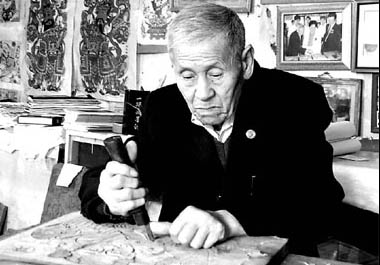With the light fragrance of the painting ink in the air, the Yang family was busy making 1,000 sets of woodblock-printed New Year paintings for a Hong Kong customer. Five or six of them were printing and binding paintings of figures from the Chinese classic novel A Dream of the Red Chamber. Giving instructions to them was an old man.
At 81, Yang Luoshu takes great pride in his work. The farmer from Yangjiabu Village, Weifang City, East China's Shandong Province, was named "Master of Folk Arts" by UNESCO in 2001. Today, his New Year paintings are hot items sought by international collectors and they have inspired some overseas disciples.
Over the past five years, Yang has been working on a grand project - a colossal collection of paintings of characters from four Chinese classic novels. To date, he has created images of 109 characters from Outlaws of the Marsh, 88 from Journey to the West, 110 from The Romance of the Three Kingdoms, and 140 from A Dream of the Red Chamber.
There is a big demand for this unique collection in many cities. Museums in Japan and South Korea have collected his works.
"As our national heirloom, the four classics enjoy the largest readership in China. I hope people can understand the literary works better with my paintings," Yang says.
In his childhood, Yang's grandfather often told him stories from the four classics. Yang has since read Outlaws of the Marsh for more than five times, and A Dream of the Red Chamber at least 10 times.
The Yangjiabu Village woodblock-printed New Year paintings adhere to the tradition that requires over 10 procedures for each painting.
Sitting in front of a window, Yang clipped a piece of paper, applied color to the board, and put the paper on it, then brushed it smoothly to apply the first color. In half an hour, he dyed 100 sheets of paper.
The pictures must be engraved on wood boards. One board is used for one color; four or five boards are needed to complete one painting. It usually takes several days to engrave one board. Yang and his followers' hands are covered with thick calluses. Swollen knuckles have deformed Yang's right hand. Three fingers are wounded permanently.
Besides the four classics, Yang has produced abundant works deeply rooted in daily life: historical personage, flower-and-bird and landscape.
With only 300 families, Yangjiabu has a history of making New Year paintings for some 600 years since the Ming Dynasty (1368-1644). In the Qing Dynasty (1644-1911), there were 100 workshops in the village with 1,000 kinds of paintings and tens of thousands of xylographs. Local lore says: "Each family has a painting workshop, and everybody is good at handicraft."
In 1993, Yang donated the family's precious engraving boards, dating back to the Ming and Qing dynasties, to the National Museum of Chinese History. Experts found that one of the boards was made in 1489, the oldest wood board of New Year paintings preserved in the country.
Today, this small village is one of three major production bases of woodblock-printed New Year paintings, together with Yangliuqing in Tianjin in North China and Taohuawu in Suzhou of East China's Jiangsu Province.
Yang says he is the 19th generation of the painting family and successor of the centuries-old shop named "Tongshunde".
When he was 7 years old, Yang began to carve wooden figures and learned from his father Yang Shengde. By 10, Yang could make paintings like a cat playing with a butterfly. At 18, he had grasped all of the production skills. Over the past 60 years, Yang and his family have engraved more than 3,270 kinds of xylographs.
For nearly 30 years, Yang has demonstrated the production of New Year paintings at the local folk-custom museum. More than 500,000 visitors have enjoyed his performance.
In 1997, Yang gave an exhibition in Tokyo. Yang Futao, his son, performed the engraving and printing of the paintings. To their surprise, not only the New Year paintings they brought there were sold out quickly, but Yang was also praised as "King of Chinese New Year Paintings" by the local media. He was invited to give lectures and perform in several colleges and art museums in Tokyo.
Nakayama Naoko, a Japanese young lady, has been an apprentice of Yang's for several years. Nakayama came from Fukuoka to work on her thesis titled Chinese Yangjiabu Village Woodblock-Printed New Year Paintings. Yang says Nakayama has a natural gift and she is diligent, so he decided to teach her hand in hand.
"I hope to introduce our New Year paintings to Japan and other countries," Yang says.
In 1999, Yang won third prize in the 11th American International Art Contest with his engraving board of Qin Qiong and Jingde, a painting of two of the most famous generals who helped Li Shimin found the Tang Dynasty (AD 618-907).
Yang's son, daughter-in-law, grandson and more than 20 other relatives have learned from him. While the men concentrate on engraving, women learn to print.
Due to Yang's great contribution to the protection, innovation and teaching of New Year paintings, UNESCO honored Yang as "Master of Folk Arts" in December 2001.
"This is the highest honor for a handicraftsman as there are only 17 Chinese who have got this title," Yang says. "This is also the highest honor for Yangjiabu Village and for the New Year paintings. With this honor, I feel satisfied."
Though advanced in years, Yang still walks and talks briskly. "It is the art of New Year paintings that gives me the exuberant vitality. I must engrave more good works with my own hands."
Yang Luoshu, 81, carves the woodblocks for New Year paintings in Weifang of East China's Shandong Province.
(China Daily August 8, 2007)


